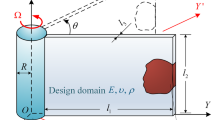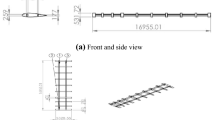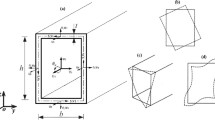Buckling of skin is admissible for upper load-bearing panels of a wing box and mechanization units of a light aircraft in case of loads close to operating level. Method of determining the optimum parameters of composite skin under action of compressive and shear flows is considered. Peculiarities of the optimum design problem are formulated as follows. Firstly, two loading levels are considered when designing the panels. At the first level, panel buckling is not admissible. At the second level, subject to the admissibility of postbuckling behavior, the panel thickness is calculated from the conditions for reaching the critical stresses determined accounting for the geometrically nonlinear relations. Secondly, the thickness and width of the rectangular panel are taken as variable parameters. Thirdly, in order to determine the optimum parameters of the panel, the conditions of realization of the minimum stability margin at the first loading level and minimum strength margin at the second loading level are taken into account. The stability and strength margins at the corresponding loading levels have to be equal unit. The loading levels above-mentioned, in general case, have to be coincided with the operating and ultimate loads considered when designing the aircraft structures, but can be given by an aircraft designer based on the special design conditions. It was noted that analytical solutions of the geometrically nonlinear problems have to be used in determining the design parameters according to the technique of postbuckling state. The relations presented take into account the membrane stresses arising at buckling of a thin panel. The technique developed can be applied at the early design stages. The relations for designing the hinge-supported orthotropic panels in compression, shear and combined loading are presented.



Similar content being viewed by others
References
V. V. Vasiliev and E. V. Morozov, Advanced Mechanics of Composite Materials and Structures, Elsevier, Amsterdam: (2018).
G. A. Teters, R. B. Rikards, and V. L. Narusberg, Optimization of Shells Made of Layered Composites, Zinatne, Riga (1978).
I. F. Obtaztsov, V. V. Vasiliev, and V. A. Bunakov, Optimal Reinforcement of Shells of Revolution Made of Composite Materials, Mashinostroenie, Moscow (1977).
N. V. Banichuk, V. V. Kobelev, and R. B. Rikards, Optimization of Structural Elements Made of Composite Materials, Mashinostroenie, Moscow (1988).
L. Kollár and G. Springer Mechanics of Composite Structures, Cambridge University Press, (2009). https://doi.org/10.1017/CBO9780511547140
B. G. Falzon and M. H. Aliabadi, Buckling and Postbuckling Structures: Experimental, Analytical and Numerical Studies, Imperial College London, UK, (2008). https://doi.org/10.1142/p506
R. Degenhardt, and J. Teßmer, “Advances in Computational Stability Analysis of Composite Aerospace Structures //AIP Conf. Proceedings, 1281, 1608–1611 (2010). https://doi.org/10.1063/1.3498128
R. Degenhardt, S. Castro, M. Arbelo, R. Zimmerman, R. Khakimova, and A. Kling, “Future structural stability design for composite space and airframe structures,” Thin-Walled Structures, 81, 29-38 (2014). https://doi.org/10.1016/j.tws.2014.02.020.
Advisory Circular 20-107B, U.S. Department of Transportation Federal Aviation Administration (2009). https://www.faa.gov/documentLibrary/media/Advisory_Circular/AC20-107B.pdf
K. Kalnins, J. Auzins, and R. Rikards, “Metamodeling approach for analysis of post-buckling in composite panels with structural degredation,” 11th AIAA/ISSMO Multidisciplinary Analysis and Optimization Conf., Portsmouth, Virginia, USA, 06-08 September (2006). https://doi.org/10.2514/6.2006-7104
K. Kalnins, J. Auzins, and R. Rikards, “Fast simulation procedure for ribbed composite structures with material degradation,” Mech. Compos. Mater., 43, No. 2., 225-232 (2007). https://doi.org/10.1007/s11029-007-0022-2
K. Kalnins, C. Bisagni, R. Rikards, E. Eglitis, P. Cordisco, and A. Chate. “Metamodels for the optimization of damage tolerant composite structures,” ICAS 2008, 26th Congress of Int. Council of the Aeronautical Sciences, Anchorage, Alaska, USA, September 14-19, (2008), 2151-2157.
H. Liu, J. Liu, Y. Ding, J. Zhou, K. Shao, B. Blackman, A. Kinloch, B. Falzon, and J. Dear “Effects of impactor geometry on the low-velocity impact behaviour of fibre-reinforced composites: an experimental and theoretical investigation,” Appl. Compos. Mater., 27, 533-553 (2020). https://link.springer.com/article/10.1007/s10443-020-09812-8
H. Liu, B. G. Falzon, and W. Tan, “Experimental and numerical studies on the impact response of damage-tolerant hybrid unidirectional/woven carbon-fibre reinforced composite laminates,” Composites, Part B, 136, 101–118 (2017). https://doi.org/10.1016/j.compositesb.2017.10.016
A. Kondratiev, O. Potapov, A. Tsaritsynskyy, and T. Nabokina, “Optimal design of composite shelled sandwich structures with a honeycomb filler,” Advances in Design, Simulation and Manufacturing IV, 546–555 (2021). https://doi.org/10.1007/978-3-030-77719-7_54
A. Kondratiev, and V. Gaydachuk, “Weight-based optimization of sandwich shelled composite structures with a honeycomb filler,” Eastern-Eur. J. of Enterprise Technologies, 1, No. 1, 24–33 (2019). 10.15587/1729-4061.2019.154928
K. V. Mikhailovskii and S. V. Baranovski, “Technique for designing a wing made of polymer composite materials based on parametric modeling. Part 3. Selection and justification of optimal reinforcement schemes for power elements,” Izvestiya Vysshikh Uchebnykh Zavedenij, Mashinostroenie, 698, No. 5, 75-84 (2018). 10.18698/0536-1044-2018-5-75-84
K. Maksimović, M. Maksimović, I. Vasović-Maksimović, B. Rasuo, and S. Maksimović, “Postbuckling and failure analysis of layered composite panels,” FME Transactions, 48, No. 2, 447-453 (2020). https://doi.org/10.5937/fme2002447M
F. Zhang, M. Wu, X. Hou, C. Han, X. Wang, and X. Xu, “Post-buckling reliability analysis of stiffened composite panels based on adaptive iterative sampling,” Eng. with Computers, 22, May, 1-11 (2021). https://link.springer.com/article/10.1007/s00366-021-01424-5
X. Ni, G. Prusty, and A. Hellier, “Buckling and post-buckling of isotropic and composite stiffened panels: A review on optimisation (2000-2015),” Transactions of the Royal Institution of Naval Architects Part A: Int. J. Maritime Eng., 158, Part A3, A-251–A-268 (2016). https://doi.org/10.5750/ijme.v158iA3.994
A. Madeo, R. M. J. Groh, G. Zucco, P. Weaver, G. Zagari, and R. Zinno, “Post-buckling analysis of variable-angle tow composite plates using Koiter’s approach and the finite element method,” Thin-Walled Structures, 110, January, 1-13 (2017). https://doi.org/10.1016/j.tws.2016.10.012
S. White, G. Raju, and P. Weaver, “Initial post-buckling of variable-stiffness curved panels,” J. Mech. and Physics of Solids, 71, November, 132-155 (2014). https://doi.org/10.1016/j.jmps.2014.07.003
H. Quadros, and J. Hernandes, “A Lagrange parametrization for the design of variable stiffness laminates,” Structural and Multidisciplinary Optimization, 58, February, 129-137 (2018). https://link.springer.com/article/10.1007/s00158-017-1882-2
Z. Wu, G. Raju, and P. Weaver, “Framework for the buckling optimization of variable-angle tow composite plates,” AIAA J., 53, No. 12, 1-17 (2015). https://doi.org/10.2514/1.J054029
F. S. Liguori, G. Zucco, A. Madeo, D. Magisano, L. Leonetti, G. Garcea, and P. Weaver, “Koiter method and solid shell finite elements for postbuckling optimisation of variable angle tow composite structures,” Proc. XXIV AIMETA Conf. 1731-1742 (2019). https://doi.org/10.1007/978-3-030-41057-5_139.
Wen Wu, R. Ba, Z. Lei, C. Geng, X. Zhang, K. Peng, J. Guo, and Y. Ma, “Buckling analysis of stiffened composite panels with variable stiffness,” IOP Conference Series: Mater. Sci. and Eng., 504, No. 1. Article number 012059, (2019). https://doi.org/10.1088/1757-899X/504/1/012059
S. Selyugin, “Locally orthotropic lay-up as an optimal solution for vat post-buckled composite plates experiencing large deflections above von Кarman limits,” engrXiv Preprints, 1-11 (2021). 10.31224/osf.io/4a6hz
S. Selyugin, “Composite plates in postbuckling: dual extremal variational principles, energy features, stability, lay-up optimality conditions via complementary energy approach ,” engrXiv Preprints, 1-17 (2019). 10.31224/osf.io/3vbj6
C. López, O. Bacarreza, A. Baldomir, S. Hernandez, and M. H. Aliabadi, “Reliability-based design optimization of composite stiffened panels in post-buckling regime,” Structural and Multidisciplinary Optimization, 55, 1121–1141 (2017). https://link.springer.com/article/10.1007/s00158-016-1568-1
H. Farokhi, O. Bacarreza, and M. H. Aliabadi, “Probabilistic optimisation of mono-stringer composite stiffened panels in post-buckling regime,” Structural and Multidisciplinary Optimization, 62, 1395–1417 (2020). https://link.springer.com/article/10.1007/s00158-020-02565-9
A. Faggiani and B. G. Falzon, “Optimization of Postbuckling-Stiffened Composite Aerostructures,” In.: Buckling and Postbuckling Structures II, Experimental, Analytical and Numerical Studies, Ch. 8, (Eds. B G Falzon and M H F Aliabadi), Queen’s University Belfast, UK, (2018), 253-284. https://doi.org/10.1142/9781786344335_0008
Z. Wu, G. Raju, and P. Weaver, “Analysis and design for the moderately deep postbuckling behavior of composite plates,” J. Aircraft, 54, No.1, 1-9 (2016). https://doi.org/10.2514/1.C033875
O. Mitrofanov, “Applied design of minimum weight composite wing panels taking into account skin post-buckling behavior,” Aerospace MAI J., 9, No.1, 35-42 (2002). http://vestnikmai.ru/publications.php?ID=32669
O. V. Mitrofanov, Designing Load-Bearing Panels of Aircraft Structures for Post-buckling state, MAI, Moscow (2020).
L. I. Balabukh, “Stability of plywood plates,” Air Fleet Technol., 9, 19-37 (1937).
O. Mitrofanov, M. Osman, and V. Gavriliak, “Composite panels design based on post-buckling state with combined loading,” J. Physics: Conference Series, 1925, No. 1, 1-9, Article number 012055 (2021). https://doi.org/10.1088/1742-6596/1925/1/012055
Author information
Authors and Affiliations
Corresponding author
Additional information
Translated from Mekhanika Kompozitnykh Materialov, Vol. 58, No. 1, pp. 21-42, January-February, 2021. Russian DOI: 10.22364/mkm.58.1.02.
Rights and permissions
About this article
Cite this article
Mitrofanov, O., Osman, M. Designing of Smooth Composite Panels Providing Stability and Strength at Postbuckling Behavior. Mech Compos Mater 58, 15–30 (2022). https://doi.org/10.1007/s11029-022-10008-3
Received:
Revised:
Published:
Issue Date:
DOI: https://doi.org/10.1007/s11029-022-10008-3




